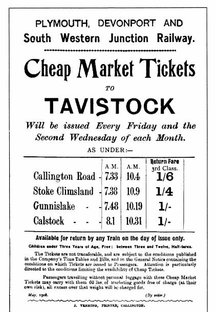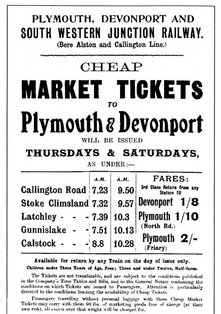Calstock to Bere Alston 100 tons 120 tons
Stations of the PD&SWJR
Devonport Kings Rd
St. Budeaux Victoria Rd
Tamerton Foliot
Bere Ferrers
Station details Opened Closed
Devonport 18th May 1876 7th September 1967
PD&SWJR Devonport to Lydford
renamed Devonport Kings Rd 26th September 1949
Albert Road Halt 1st October 1906 13 January 1947
Ford 2nd June 1890 7th September 1964
Camels Head Halt 1st November 1906 4th May 1942
Weston Mill Halt 1st November 1906 September 1921
St Budeaux (called St. Budeaux for Saltash in timetable) 2nd June 1890
renamed St. Budeaux Victoria Rd 26th September 1962
TamertonFoliot 1st January 1898 10th September 1962
Beer Ferris 2nd June 1890
renamed Bere Ferrers - November 1897
Beer Alston 2nd June 1890
renamed Bere Alston - November 1897
Tavistock North 2nd June 1890 6th May 1968
Brentor 2nd June 1890 6th May 1968
Lidford 12th October 1874 6th May 1968
renamed Lydford July 1897
Devonport Kings Road Station data
Terminus and signal box opened 18 May 1876
Stonehouse Pool branch opened to goods traffic 1 March 1886
Double track PDSWJR line from Lidford opened to goods traffic and Devonport station converted from a terminus to a through station 12 May 1890
Lidford line opened to public passenger traffic 2 June 1890
Stonehouse Pool line opened to passengers 9 April 1914
Stonehouse Pool line closed to passengers 28 May 1910
Station renamed Devonport Rings Road 26 September 1949
Line to St. Budeaux and passenger station closed 7 September 1964
Signal box closed 14 March 1965
Line to Devonport Junction singled 26 February 1967
Goods station, Storehouse Pool branch and line to Devonport Junction closed 7 March 1971
Station transactions
BERE FERRERS 1928 1936
Number of passenger tickets issues 16259 15812
Number of season tickets issued 100 162
Number of passenger tickets collected 36130 34394
Number of telegrams 285 66
Number of parcels forwarded 1201 1782
Number of parcels received 402 567
Milk forwarded (cans 1928/gallons 1936) 2963 15552
Milk received (cans 1928/gallons 1936) 2 ---
General goods forwarded (tons) 140 44
General goods received (tons) 181 92
Coal, coke etc. received (tons) 89 80
Other minerals forwarded (tons) 65 ---
Other minerals received (tons) 113 ---
Trucks of livestock forwarded 49 11
Trucks of livestock received 3 ---
Lavatory pennies 300 167
LYDFORD (originally Spelt LIDFORD)
Tavistock - Launceston broad gauge opened 1 July 1865
LSWR Oakhampton - Lidford and first LSWR signal box opened 12 October 1874
LSWR Lidford - Devonport via GWR opened 17 May 1879
PD&SWJR Lidford - Devonport opened 2 June 1890
GWR Broad gauge abolished May 1892
Renamed Lydford July 1897
LSWR/GWR connection removed 19 Dec 1915
LSWR and GWR signal boxes closed, joint signal box opened 8 Jan 1917
New SR/GWR connection and new sidings opened 30 May 1943
Ex-GWR services withdrawn 31 Dec 1962
Ex-GWR Tavistock line closed 25 Sep 1964
Ex-GWR Launceston line closed 28 Feb 1966
Line completely closed 6 May 1968
Bere Alston
Tavistock North
Brentor
Lydford
Bere Alston - branch train
Calstock
Gunnislake
Chilsworthy Halt
Latchley
Luckett
Callington
PD&SWJR Bere Alston to Callington
Opened Closed
Bere Alston 2nd June 1890
Calstock 2nd March 1908
Station details
Gunnislake (new station) May 1994
Gunnislake (old station) 2nd March 1908 30th January 1994
Chilsworthy 1st June 1909 7th November 1966
Latchley 2nd March 1908 7th November 1966
Seven Stones Halt June 1910 September 1917
Stoke Climsland 2nd March 1908 7th November 1966
renamed Luckett 1st November 1909
Callington Road 2nd March 1908 7th November 1966
renamed Callington - 1949
renamed Callington for Stoke Climsland - 1st November 1909
A number of PD&SWJR stations were on the site of former ECMR (East Cornwall Mineral Railway) goods depots
Gunnislake was formerly Drakewalls
Latchley was formerly Cox's Park
Luckett was formerly Monks Corner
Callington Road was formerly Kelly Bray
Phone codes
Each station had its own internal phone code, these were
Bere Alston booking office 2 - 3
Bere Alston signal box 3
Calstock 2
Gunnislake 4
Luckett 2 - 1
Callington 1 - 3
Bere Alston to Callington – Loads of trains 1960
LOADS OF TRAINS ETC – The maximum loads of passenger trains over this branch are as under:-
Class of engine
Section of line 0.2. 2.M.T.T.
Calstock to Callington 100 tons 120 tons
Callington to Calstock 260 tons 260 tons
Bere Alston to Calstock 260 tons 260 tons
Shunting Kit Hill
Kit Hill (Wm. Griffiths & Co.) siding. The shunting operations are performed by the Guards of the trains concerned.
uncoupled and the hand brakes applied. The engine must then be detached and run forward beyond the points leading to the siding, the points set for the siding, and the wagons allowed to gravitate into the siding clear of the catch points. The points must then be set for the running line, and the engine re-coupled to the train.
Traffic from the siding will be taken on by down goods trains and conveyed to Callington en route to destination, the van brakes to be applied and a sufficient number of wagon brakes securely applied before the engine is detached from the train and allowed to proceed into the siding for the wagons.
Wagons for the siding are conveyed from Callington and must be attached next the engine of up goods trains. On arrival of the train at the siding, the van brake must be fully applied and a sufficient number of wagon brakes securely applied, after which the wagons to be placed in the siding must be

